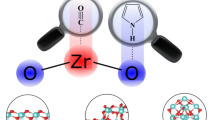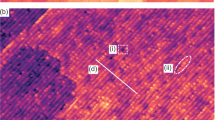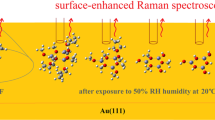Abstract
We present azimuth- and polarization-dependent infrared spectroscopy results obtained under ultra-high vacuum conditions on surface species formed by the interaction of formic acid with the mixed-terminated ZnO(10\(\bar{1}\)0) surface. Since there are no previous IRRAS data for formic-acid derived species on any ZnO single crystal surfaces, we have carried out calculations using density function theory to aid the interpretation of the results. From our combined experimental and theoretical data we conclude that two different formate species are formed. The more strongly bound species is a bidentate with the formate molecular plane oriented along the [1\(\bar{2}\)10] direction. The less strongly bound species is a quasi-bidentate with its molecular plane oriented along the [0001] direction. This second species is characterized by a strong hydrogen bond between a surface OH species and the formate. In addition, IR data were recorded for the same molecule adsorbed on commercial ZnO nanoparticles. The different bands of the powder IR-data are assigned on the basis of the experimental and theoretical results obtained for the single crystal surface. This study demonstrates the importance of the Surface Science approach to heterogeneous catalysis also for ZnO, an important catalyst for the conversion of syngas to methanol.







Similar content being viewed by others
References
Hansen JB, Højlund Nielsen PE (2008) Methanol Synthesis. In: Handbook of Heterogeneous Catalysis. Wiley. doi:10.1002/9783527610044.hetcat0148
Grabow LC, Mavrikakis M (2011) Mechanism of methanol synthesis on Cu through CO2 and CO hydrogenation. Acs Catal 1(4):365–384
Mittasch A, Pier M (1924) Synthetic manufacture of methanol. United States Patent US 1569775, 12. Jan 1926
Grätzel M (2001) Photoelectrochemical cells. Nature 414(6861):338–344
Grätzel M (2003) Dye-sensitized solar cells. J Photochem Photobio C 4(2):145–153
Anta JA, Guillén E, Tena-Zaera R (2012) ZnO-based dye sensitized solar cells. J Phys Chem C 116(21):11413–11425
Davis R, Walsh JF, Muryn CA, Thornton G, Dhanak VR, Prince KC (1993) The orientation of formate and carbonate on ZnO(10-10). Surf Sci 298(1):L196–L202
Crook S, Dhariwal H, Thornton G (1997) HREELS study of the interaction of formic acid with ZnO(10-10) and ZnO(000-1)-O. Surf Sci 382(1–3):19–25
Lenz A, Selegard L, Söderlind F, Larsson A, Holtz PO, Uvdal K, Ojamäe L, Kall PO (2009) ZnO nanoparticles functionalized with organic acids: an experimental and quantum-chemical study. J Phys Chem C 113(40):17332–17341
Teklemichael ST, McCluskey MD (2012) Compensation of acceptors in ZnO nanocrystals by adsorption of formic acid. J Phys Chem C 116(32):17248–17251
Hayden BE, King A, Newton MA (1999) Fourier transform reflection-absorption IR spectroscopy study of formate adsorption on TiO2(110). J Phys Chem B 103(1):203–208
Mattsson A, Hu S, Hermansson K, Österlund L (2014) Adsorption of formic acid on rutile TiO2 (110) revisited: an infrared reflection-absorption spectroscopy and density functional theory study. J Chem Phys 140(3):034705
Nakatsuji H, Yoshimoto M, Umemura Y, Takagi S, Hada M (1996) Theoretical study of the chemisorption and surface reaction of HCOOH on a ZnO(10-10) surface. J Phys Chem 100(2):694–700
Persson P, Ojamae L (2000) Periodic Hartree–Fock study of the adsorption of formic acid on ZnO(10-10). Chem Phys Lett 321(3–4):302–308
Persson P, Lunell S, Ojamae L (2002) Quantum chemical prediction of the adsorption conformations and dynamics at HCOOH-covered ZnO(10-10) surfaces. Int J Quantum Chem 89(3):172–180
Xu MC, Noei H, Buchholz M, Muhler M, Wöll C, Wang YM (2012) Dissociation of formic acid on anatase TiO2(101) probed by vibrational spectroscopy. Catal Today 182(1):12–15
Freund HJ, Kuhlenbeck H, Libuda J, Rupprechter G, Bäumer M, Hamann H (2001) Bridging the pressure and materials gaps between catalysis and surface science: clean and modified oxide surfaces. Top Catal 15(2–4):201–209
Wang Y, Kováčik R, Meyer B, Kotsis K, Stodt D, Staemmler V, Qiu H, Traeger F, Langenberg D, Muhler M, Wöll C (2007) CO2 activation by ZnO through the formation of an unusual tridentate surface carbonate. Angew Chem Int Ed 46(29):5624–5627
Buchholz M, Weidler PG, Bebensee F, Nefedov A, Wöll C (2014) Carbon dioxide adsorption on a ZnO (10-10) substrate studied by infrared reflection absorption spectroscopy. Phys Chem Chem Phys 16:1672–1678
Greenler RG (1966) Infrared study of adsorbed molecules on metal surfaces by reflection techniques. J Chem Phys 44(1):310–315
Greenler RG, Snider DR, Witt D, Sorbello RS (1982) The metal-surface selection rule for infrared spectra of molecules adsorbed on small metal particles. Surf Sci 118(3):415–428
Wöll C (2007) The chemistry and physics of zinc oxide surfaces. Prog Surf Sci 82(2–3):55–120
Wang Y, Glenz A, Muhler M, Wöll C (2009) A new dual-purpose ultrahigh vacuum infrared spectroscopy apparatus optimized for grazing-incidence reflection as well as for transmission geometries. Rev Sci Instrum 80(11):113106–113108
Kresse G, Furthmüller J (1996) Efficient iterative schemes for ab initio total-energy calculations using a plane-wave basis set. Phys Rev B 54(16):11169–11186
Kresse G, Furthmüller J (1996) Efficiency of ab initio total energy calculations for metals and semiconductors using a plane-wave basis set. Comput Mater Sci 6(1):15–50
Kresse G, Hafner J (1993) Ab-Initio molecular-dynamics for open-shell transition-metals. Phys Rev B 48(17):13115–13118
Perdew JP, Wang Y (1992) Accurate and simple analytic representation of the electron-gas correlation-energy. Phys Rev B 45(23):13244–13249
Blöchl PE (1994) Projector augmented-wave method. Phys Rev B 50(24):17953–17979
Meyer B, Marx D (2003) Density-functional study of the structure and stability of ZnO surfaces. Phys Rev B 67(3):035403
Karzel H, Potzel W, Kofferlein M, Schiessl W, Steiner M, Hiller U, Kalvius GM, Mitchell DW, Das TP, Blaha P, Schwarz K, Pasternak MP (1996) Lattice dynamics and hyperfine interactions in ZnO and ZnSe at high external pressures. Phys Rev B 53(17):11425–11438
Duke CB, Meyer RJ, Paton A, Mark P (1978) Calculation of low-energy-electron-diffraction intensities from ZnO (1010).2. Influence of calculational procedure, model potential, and 2nd-layer structural distortions. Phys Rev B 18(8):4225–4240
Monkhorst HJ, Pack JD (1976) Special points for Brillouin-zone integrations. Phys Rev B 13(12):5188–5192
Baroni S, de Gironcoli S, Dal Corso A, Giannozzi P (2001) Phonons and related crystal properties from density-functional perturbation theory. Rev Mod Phys 73(2):515–562
Pick RM, Cohen MH, Martin RM (1970) Microscopic theory of force constants in adiabatic approximation. Phys Rev B 1(2):910–920
Gonze X, Lee C (1997) Dynamical matrices, born effective charges, dielectric permittivity tensors, and interatomic force constants from density-functional perturbation theory. Phys Rev B 55(16):10355–10368
Karhanek D, Bucko T, Hafner J (2010) A density-functional study of the adsorption of methane-thiol on the (111) surfaces of the Ni-group metals: II.Vibrational spectroscopy. J Phys Condens Matter 22(26):265006
Noei H (2010) Vibrational spectroscopic Studies on Adsorption and Reactions over ZnO—based Catalysts. Dissertation, Ruhr-Universität Bochum, Bochum
Kähler K, Holz MC, Rohe M, Strunk J, Muhler M (2010) Probing the reactivity of ZnO and Au/ZnO nanoparticles by methanol adsorption: a TPD and DRIFTS study. ChemPhysChem 11(12):2521–2529
Busca G, Lorenzelli V (1982) Infrared spectroscopic identification of species arising from reactive adsorption of carbon oxides on metal oxide surfaces. Mater Chem 7(1):89–126
Nakamoto K (2008) Applications in coordination chemistry. Infrared and Raman spectra of inorganic and coordination compounds. Wiley, Hoboken
Petrie WT, Vohs JM (1991) An HREELS investigation of the adsorption and reaction of formic acid on the (0001)-Zn surface of ZnO. Surf Sci 245(3):315–323
Koßmann J, Roßmüller G, Hättig C (2012) Prediction of vibrational frequencies of possible intermediates and side products of the methanol synthesis on ZnO(000\(\overline{1}\)) by ab initio calculations. The Journal of Chemical Physics 136 (3):034706
Acknowledgements
M.B. and Q. L. thank the financial support from the Helmholtz Research School “Energy-related catalysis”. We thank S. Heißler (IFG) for his support and F. Bebensee for helpful discussions.
Author information
Authors and Affiliations
Corresponding author
Electronic supplementary material
Below is the link to the electronic supplementary material.
Rights and permissions
About this article
Cite this article
Buchholz, M., Li, Q., Noei, H. et al. The Interaction of Formic Acid with Zinc Oxide: A Combined Experimental and Theoretical Study on Single Crystal and Powder Samples. Top Catal 58, 174–183 (2015). https://doi.org/10.1007/s11244-014-0356-7
Published:
Issue Date:
DOI: https://doi.org/10.1007/s11244-014-0356-7




